
Original Link: https://www.anandtech.com/show/1558
ATI's New Radeon X850 and X800 Lines: A Smorgasbord of GPUs
by Anand Lal Shimpi & Derek Wilson on December 1, 2004 9:41 AM EST- Posted in
- GPUs
Some people didn't expect it to happen this season, and it is a little late in the year. But it is still fall, and, still on schedule, ATI's fall refresh part is here. Maintaining the 6 month product cycle has been quite struggle over the past few years, and seems to have stretched into something more like 7 or 8 months. We'll have to wait and see what happens this spring before we can really see if the industry is going to start relaxing the product cycle a little, or if this last round was just a little more intense for both ATI and NVIDIA. Today sees the introduction of a new PCI Express only line up from ATI. Rumor has it that ATI will be finishing up their PCI Express to AGP bridge chip sometime in January, so we may see these and other products make their way across platforms sometime next quarter.
The two new chips that ATI is putting on cards today are the R480 and R430. The R480 is the higher end part in this case. There is absolutely no architectural difference between these new chips and the original R423 on which they are based. That being said, they are both, in fact, different chips than their predecessor. This magical fact is made possible through the wonders of process enhancements.
As a fabrication process matures, it is often possible to find ways to do things better, more efficiently, and with fewer defects in the final silicon. These are the types of process enhancements that go on most of the time at any given fab. Generally, as the process gets better, yield improves, costs go down, and profits go up. In the case of the current generation of graphics cards, it took quite a while to go from launch to high availability. Occasionally, it's also possible to find ways of doing things that enhance the performance of the final product as well. At this point, TSMC has been using their 130nm low-k process to fab ATI's R420 and R423 chips for quite some time now.
Having gotten quite comfortable with the 130nm low-k fab technology, as well as the R423, TSMC and ATI have been able to refine the process for the R480 by enhancing the silicon substrate through component selection and placement to further improve signal integrity leading to higher core clock frequencies. They were also able to shorten trace lengths from the core to memory. Unfortunately, we couldn't get ATI to go into any more detail on exactly what "substrate enhancements" were made, but shorter trace lengths translates to the possibility of higher stable memory clock speeds for ATI cards using the enhanced R480 chip.
The differences between the R423 and the R430 are clearer cut. The R430 is fabbed on the 110nm process rather than the 130nm low-k process. ATI isn't able to push the R430 chips at clock speeds that rival the R480, but this matches well with cooler running, lower clocked 16 and 12 pixel pipe solutions (which is exactly what ATI is offering with R430 based cards).
In addition to the fact that the R480 will be a high performance part, it will also be packed on two slot cards. The stock thermal solution ATI provides is quite different from what we've seen in the past, and quite resembles the leaf-blower type systems we've seen attached to older GeForce FX based products. Aside from the hi-revving but throaty turbo charged 4-cylinder-like whine at boot time, the card calms down and runs quite quietly even under the highest gaming stress. To be completely fair, we haven't tested it in oven-like weather or at a constant high overclock. If the fan has to spin all the way up, you may get the feeling you've got a Civic with an aftermarket exhaust racing around in your box.
Just so you get an idea of what it sounds like, we've provided an mp3 of our X850 XT PE testbed starting up. The sound level of the fan at the end of the MP3 is the loudest it ever got for us during our testing, but once again we were testing in an open air environment and not in a closed (potentially quite warm) case. For a comparison point, here is an mp3 of the same testbed with an X800 XT starting up.
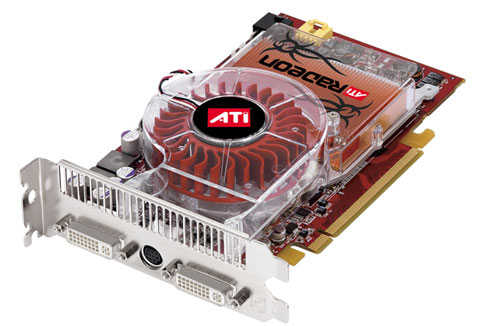
Dual DVI and Dual Slots are the markings of ATI's X850 line
If owning a single slot solution is a deciding factor, the R430 will fulfill that niche. The lower clocked, 110nm solution won't be fitted with the leaf-blower, but a much smaller hsf. ATI has said that it will be possible to passively cool one of these in a BTX system as well. Getting very quiet, very solid performance out of these chips will be a simple matter.
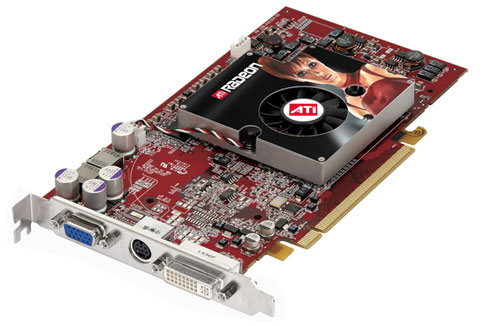
A single slot and no power connector are the telling characteristics of ATI's 0.11-micron X800 line
Product will likely begin shipping early next week, as this is when it will be available for order online. It won't show up on brick and mortar shelves for a few more weeks. Getting product out the door has been a tough thing for ATI and NVIDIA in the past, especially for their highest end parts. As all parties involved have had some practice with this part for a while, we would have been happier if ATI had gotten on the ball and had product on shelves today, if they do ship next week, they won't be in bad shape. We can't say enough about how important it is to make product available as close to a launch as possible. It doesn't matter how well we compare products if it's impossible to get a hold of them. Unfortunately, unless product is available at launch, it makes it very hard for us to guess when we will see anything come along. Our case and point is the X700 XT. It wasn't available at launch, and we may never see it if the cards we look at today make it out the door.
But that's enough about the chips; let's take a look at what we can expect to see in the way of actual products equipped with these new improved GPUs.
The New ATI Lineup
All told, ATI is launching 5 new products based on two new cores this fall: 3 cards in a new 2 slot line dubbed X850 (based on R480), and 2 cards rounding out the lower end of the X800 line (built on the R430 core). Upon seeing the full list of new cards offered, we were very interested to see just how the performance numbers would fall out. From the MSRPs ATI gave us, the targets are quite apparent. Here's a quick rundown of exactly what we're looking at.
| ATI R480/R430 Product Lineup | |||||||
Corec |
memc |
ppipe |
ddvi |
mem |
fab |
price |
|
| Radeon X850 XT PE | 540 |
1.18 |
16 |
yes |
256 |
0.13 |
$549 |
| Radeon X850 XT | 520 |
1.08 |
16 |
yes |
256 |
0.13 |
$499 |
| Radeon X850 Pro* | 520 |
1.08 |
12 |
no |
256 |
0.13 |
$399 |
| Radeon X800 XL | 400 |
1 |
16 |
no |
256 |
0.11 |
$349 |
| Radeon X800 | 400 |
700 |
12 |
no |
128 |
0.11 |
$249 |
This time around, ATI thinks we are ready for a new ultra high end price point. The inclusion of the X850 XT Platinum Edition at $549 is a real product this time around, as opposed to the previous X800 XT PE as a kind of ATI sanctioned overclocked version of the X800 XT.
With the extra 20MHz over the X800 XT PE core, and the effective memory clock boost of 60MHz, the new X850 XT PE will put in a top showing across the board. Actually being available this time around means that we have a significantly faster card available to anyone who wants it. If we consider the former top of the line to be the more available X800 XT (with 500/1GHz clocks), then we are looking at maximum theoretical performance gains of 8% (40MHz core clock increase) for processing intensive games. Of course, the increase in memory clock will help push that ceiling up in some cases (especially when we start looking at bandwidth intensive high resolutions with AA and AF enabled).
Currently the X850 XT PE doesn't have any formal competition from NVIDIA in the form of a sanctioned part. It may have been possible to find a 6800 Ultra Extreme on the market if one looked hard enough and had the money to spend, but at this point the top of the line NVIDIA product we can put up against the ATI's line will be the 6800 Ultra. That may change if NVIDIA decides to bring out something new, but we still haven't heard what they have in store for us. Only time will tell, but for now we can expect the X850 XT PE to perform (and cost) head and shoulders above anything NVIDIA has on the table.
In terms of power consumption the X850 XT PE breaks new records for single card power consumption as it drew more power than its predecessor as well as NVIDIA's GeForce 6800 Ultra:

The X850 XT looks to be almost the same product the X800 XT PE was. The only difference is a slight drop in memory clock (an effective 40MHz). We can expect roughly the same performance we saw from the older, impossible to find, part. We never saw anything but an AGP version of the X800 XT PE in our labs. In any case, the tiny difference in memory clock isn't going to make much of a difference in the performance of this new part and the older one, and probably just adds a tiny bit of headroom. ATI is hinting at the fact that they may have a new version of their overdrive software (with a little more user control) coming down the pipe. Maybe even this part, with its huge cooling solution and PCI Express power, will have a little room to fly. We'll have to wait until we get a shipping card in our labs to determine that though. From the NVIDIA side, the GeForce 6800 Ultra is the current competitor to the X850 XT, and we will be putting this part to the test in our benchmarks to see how it stacks up.
The X850 Pro looks to be a filler part. The difference between the XT and the Pro will be the 12 pixel pipelines, and the fact that the Pro will come in a DVI + analog configuration rather than the dual DVI setup of the two higher end models. The current X800 Pro has its clocks set at 475/900. The new X850 Pro will bump the performance of this up a bit (as well as add about $100 to what current X800 Pros are going for). The NVIDIA GeForce 6800 GT could have some heavy competition from this part if ATI got some performance out of it, but the older X800 Pro wasn't always able to keep up with the 6800 GT either. This higher clocked part just might have what it takes if ATI can put a little more power into it before it's clock speeds are officially set in stone. But that's one of the things we'll have to wait to find out.
The new X800 cards won't be available until January, and we don't have any actual samples in our labs yet. ATI only sent their flagship X850 XT Platinum Edition out to reviewers, but since all of the X850 and X800 cards use clock variations on shipping GPUs we could look at the performance of all of ATI's launches today using other cards clocked to lower (or sometimes higher) speeds.
The X800 XL and X800 cards are supposed to fall within the current X800 line in performance. ATI lists the X800 between the X800 SE and X800 Pro, and the X800 XL just above the X800 Pro. Unfortunately, we haven't located any 12-pipe NVIDIA GeForce 6800 PCI Express solutions, so we can't round out the comparisons on the low end as much as we'd like.
The X800 XL will be a cheap way to get the benefits of 16 pixel pipe parallelism, even if overall bandwidth is reduced by core clock speed. This makes it more appealing than some slightly higher clocked 12-pipe cards in many ways. There is some trade off though: since all the X800 series cards have 6 vertex pipelines, higher clock speed does directly translate to better geometry performance. This will be a fun part to watch in the benchmarks.
At the lower end today, we have the X800. This is just a 12 pixel pipe part with lower core and memory clocks than the current X800 Pro. This should leave us with very similar performance characteristics to the current X800 Pro, just at what ATI is calling a $250 price point. We haven't seen the 8 pipe X800 SE selling at that price on the AGP side. With the X700 line pushing up against 250 from below, this could be very good for the midrange consumer.
Lightning Fast, and CPU Bound
The high performance of cards like the Radeon X850 XT Platinum Edition dictate that, even on today's fastest CPUs, they will be CPU bound at resolutions lower than 1600 x 1200. To prove this we've taken three GPU limited benchmarks, Half Life 2, Doom 3 and Far Cry, and showed their performance scaling vs. resolution using the X850 XT PE on an Athlon 64 4000+:
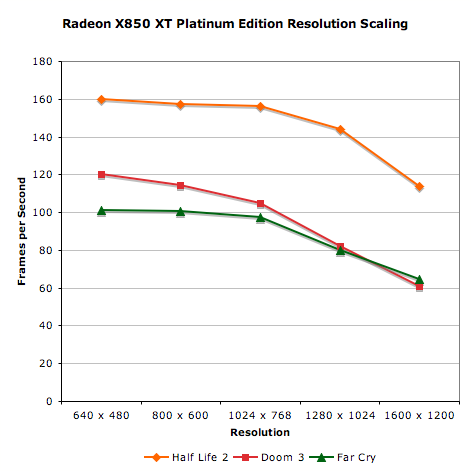
So what does this tell us? It tells us that these high end cards are CPU bound up until 1280 x 1024. It is only at 1280 x 1024 that the X850 XT PE becomes GPU limited and even more so at 1600 x 1200. It's for this reason that we conducted all of our performance tests today at 1600 x 1200.
ASUS nForce4 A8N-SLI Deluxe Motherboard
AMD Athlon 64 4000+
1GB Corsair DDR400
NVIDIA ForceWare 67.02 Drivers
ATI Beta Catalyst Drivers 8.08-041111a-019256E (no Catalyst version has been assigned to this package yet)
Windows XP Service Pack 2 with DirectX 9.0c
All performance tests were run at 1600 x 1200, some benchmarks were also run at 1600 x 1200 with 4X AA and 8X AF enabled.
To continue our recent trend of looking at head to head comparisons between GPUs first and then looking at the broad spectrum of performance we begin by evaluating the impact of each one of ATI's new GPUs individually starting with the flagship, the Radeon X850 XT Platinum Edition.
ATI's Radeon X850 XT Platinum Edition
Compared to the X800 XT:
Compared to ATI's previous flagship, the X850 XT PE offers a 0 - 10% increase in performance, with the biggest gains coming in Battlefield and Doom 3. The performance improvements aren't negligible, but definitely no reason to upgrade from a X800 XT. If you're stuck choosing between the two, what's another $50 when you're already spending $500 on a video card?
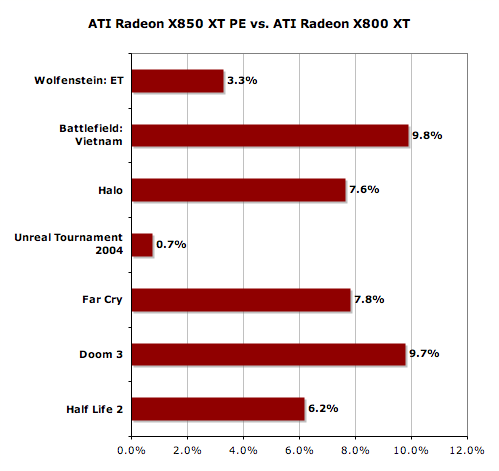
Compared to NVIDIA's GeForce 6800 Ultra:
Next up we have the X850 XT PE compared to NVIDIA's flagship, the GeForce 6800 Ultra, which is currently only available through OEMs in a PCI Express version.
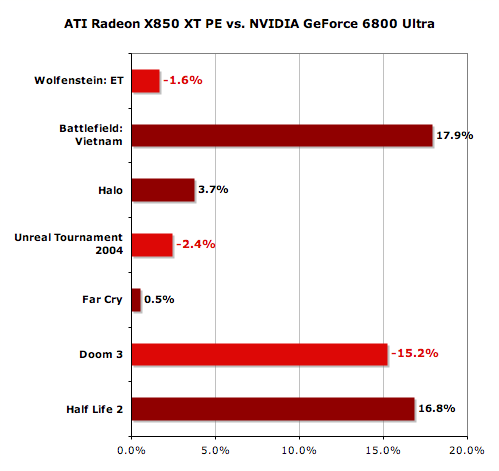
ATI has always done better in Battlefield than NVIDIA has, so it's no surprise to see the X850 XT PE with a huge advantage there. The rest of the games are basically a wash with the exception of Doom 3 and Half Life 2. Under Doom 3, the X850 XT PE is about 15% slower than the GeForce 6800 Ultra, but the tables are turned as soon as you look at Half Life 2, where the X850 XT PE is almost 17% faster than the GeForce 6800 Ultra. So which card do you pick? Well, both happen to run every single game out on the market just fine at the highest resolutions/detail settings so you can't really go wrong either way. The issue here is predicting whether more developers will use Valve's Source engine or id's Doom 3 engine for future games, and at this point that's a tough prediction to make.
The Radeon X850 XT Platinum Edition basically offers smoother playability at 1600 x 1200 in all of today's games (including Half Life 2 and Doom 3) than either of the previous reigning champions, the X800 XT and the GeForce 6800 Ultra. Now let's have a look at the rest of the X850 line...
ATI Radeon X850 XT
Compared to the Radeon X850 XT Platinum Edition:
The $50 for the Platinum Edition looks like it'll give you between a 1 and 5% performance boost at 1600 x 1200 over the not-so-platinum Radeon X850 XT, not a huge improvement.
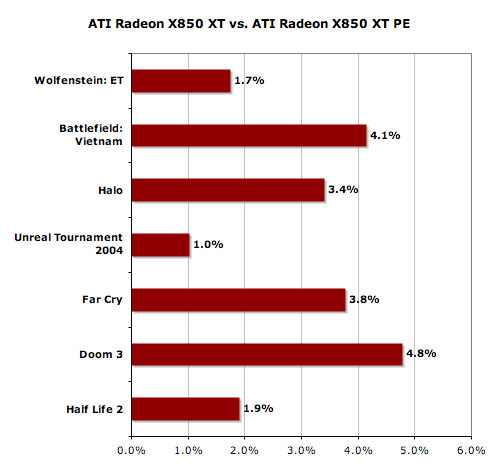
Compared to the Radeon X800 XT:
Compared to the X800 XT, the X850 XT is about 0 - 5% faster, which isn't bad considering it's at the same price point as the now "old" X800 XT. While it is unlikely, if the introduction of the X850 XT drives X800 XT prices down further then we're all for picking up a X800 XT instead. The problem is that the X800 XT was quite rare to begin with, so it's more likely that stock of the X800 XT will just dry up and will be replaced by the X850 XT.
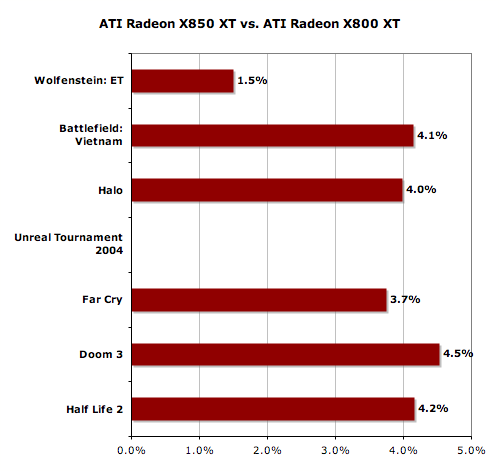
Compared to NVIDIA's GeForce 6800 Ultra:
Things don't look as balanced when you compare the X850 XT to the 6800 Ultra. Once again we see that Half Life 2 and Battlefield go to ATI, while Doom 3 continues to be a staunch NVIDIA supporter.
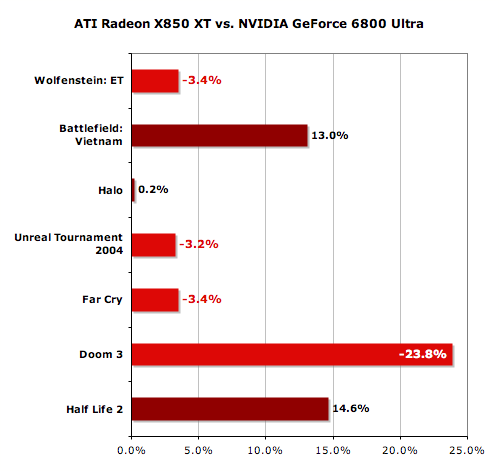
ATI Radeon X850 Pro
Out of all of the GPUs being announced today, the Radeon X850 Pro was the only one ATI did not confirm the clock speeds of. While they listed a core clock speed of 520MHz with 1.08GHz memory, we will have to wait until they actually ship the X850 Pro before knowing for sure. That being said, we couldn't resist comparing ATI's upcoming $400 GPU to the competition to see if at ATI's currently spec'd clock speeds, if it could compete.
Compared to the Radeon X800 Pro:
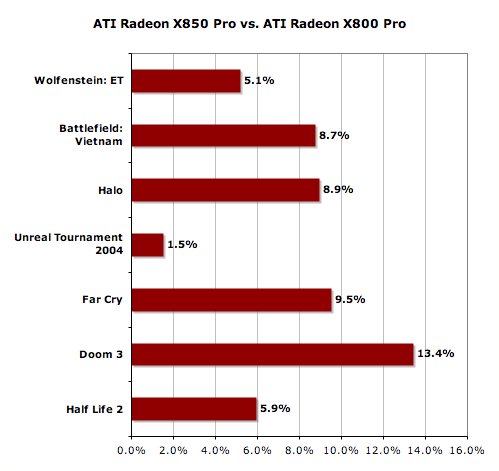
The X850 Pro offers a pretty reasonable spread of performance improvements over the X800 Pro, so it gets our thumbs up as a good replacement product to the X800 Pro. Higher core clock and memory clock will mean better performance across the board, but is a better performing X800 Pro what ATI needs right now?
Compared to NVIDIA's GeForce 6800GT:
Compared to NVIDIA's $400 part however, the X850 Pro tends to disappoint. At these clock speeds, the X850 Pro can only offer a 7.1% performance advantage in Half Life 2, and a 5 - 27% performance deficit in other games. If ATI were launching the X850 Pro at these clock speeds today we'd have to give our recommendation at $400 to the GeForce 6800GT.
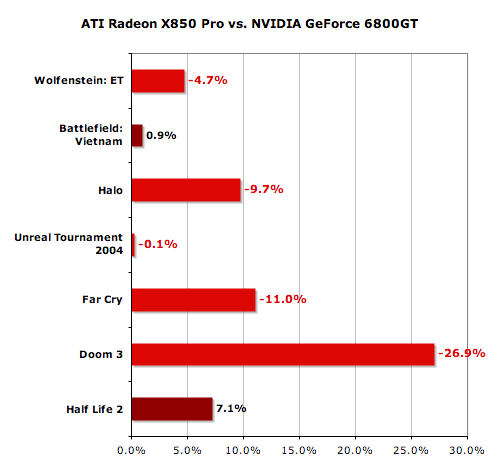
ATI Radeon X800
The Radeon X800 is sort of the inverse of the X850 Pro: its basically an underclocked version of the X800 Pro. With a 400MHz core clock and moderately paced 700MHz (effective) memory, this cheap, 12 pixel pipeline, 128mb card is ATI's answer to NV41 (GeForce 6800 non-Ultra). Of course, it's a lot easier to win that battle on the PCI Express side when NV41 is still only really stuck on AGP cards. It will be very interesting to look back and see whose strategy ended up working out better through this transition period. ATI has really made an agressive leap into the arms of PCI Express.
Compared to NVIDIA's GeForce 6600GT:
Showing a 1 - 19% performance lead over the 6600 GT in just every game but Doom 3, the X800 definitely proves its worth here. The 22% lead the 6600 GT holds in Doom 3 does help a little, but the X800 posts 3 big wins and only the one loss.
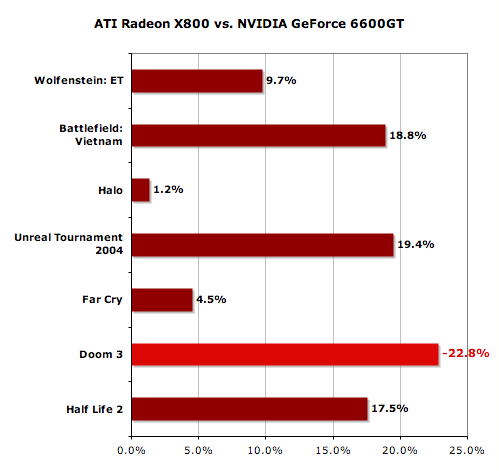
We weren't able to test the X700 XT for this review, but does ATI even need to bring out a X700 XT now? Looks like they've gotten off the hook again, first the XT PE now the X700 XT. Who would buy a X700 XT at $250 when you can get a Radeon X800 for that price? The introduction of both products makes less sense the X850 Pro.
The X800 isn't a bad part, especially in terms of its price point. Competition with the 6600 GT and the 6800 non-ultra (when it comes to PCI Express) will be strenghtened. With the X700 Pro on the market and the Radeon X800 holding up the $250 price segment, ATI will do just fine in the midrange. Now they just need to get some of the products out on AGP platforms.
ATI Radeon X800 XL
This is probably the most interesting and oddly priced part we've taken a look at today. At a $350 MSRP, we need to compare it to $399 and $299 parts. Since it's a 16 pipeline part with 256MB of RAM and a 1GHz memory data rate, we can expect some very good numbers on this card, even at lower core clock speeds. The width of the architecture really helps when scaling down.
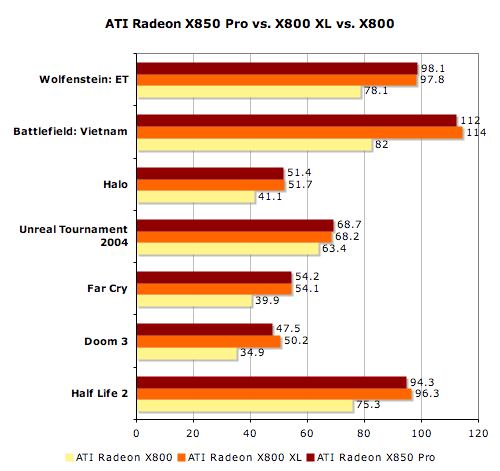
Performing as good or better than a part that's $50 more expensive in every test we run is quite an acheivement. Yes, the the X850 Pro has a 30% higher core clock speed, but the 30% increase in pixel pipelines from 12 to 16 negates that. Eventhough the X850 Pro has a little more memory bandwidth, the fact that the X800 XL is wider give is the advantage in parallelism. The X800 XL is just a better card than the X850 Pro, especially at the $349 price point ATI is shooting for.
Clearly the X800 XL is worth the added $100 investment over the vanilla X800 if it's in the budget. In every game we tested but UT2K4 the difference was larger than 24%, and could even mean playability under Doom 3 or Farcry under high stress conditions.
At a $350 price point, the X800 XL stacks up to be a very nice part. Unfortunately for ATI, it also elimiates their own current $400 incarnation of the X850 Pro as a viable entity. We find it very hard to believe that ATI would release a $350 card that would outperform a $400 card they just released a few weeks earlier so either, the clock speeds of the X800 XL and/or X850 Pro will dramatically change between now and when they are actually available, or the X800 XL and X850 Pro will be priced differently than what we've been told.
There's a quick evaluation of ATI's new lineup, but if you want to see all cards compared side by side, here you go...
Half Life 2
| Half Life 2 Performance Summary | |||||
| at_canals_08 | at_coast_05 | at_coast_12 | at_prison_05 | at_c17_12 | |
| ATI Radeon X850 XT PE | 116.1 | 134.2 | 111.3 | 114 | 84.6 |
| ATI Radeon X850 XT | 112.6 | 133.6 | 109.4 | 109.6 | 84.4 |
| ATI Radeon X800 XT | 104.9 | 129.2 | 104 | 106.6 | 83 |
| ATI Radeon X800 XL | 92.3 | 121.1 | 97 | 90.8 | 80.2 |
| NVIDIA GeForce 6800 Ultra | 95.6 | 116.4 | 96.4 | 91.6 | 79.7 |
| NVIDIA GeForce 6800GT | 85.5 | 108.8 | 89.3 | 80.3 | 76.2 |
| NVIDIA GeForce 6600GT | 58.3 | 79.4 | 65.1 | 55.8 | 62.1 |
| ATI Radeon X800 | 66.8 | 98.1 | 73.6 | 65.9 | 72.3 |
| ATI Radeon X850 Pro | 91.1 | 118.7 | 93.6 | 87.7 | 80.4 |
| ATI Radeon X800 Pro | 84.1 | 113.1 | 87.7 | 82 | 78.3 |
For our performance graph, we took our five performance tests and averaged the scores. The results here show the top of the line NVIDIA GeForce 6800 Ultra performing on par with the new Radeon X850 Pro and X800 XL parts. The DirectX based, shader heavy game by Valve clearly runs faster on ATI's hardware.
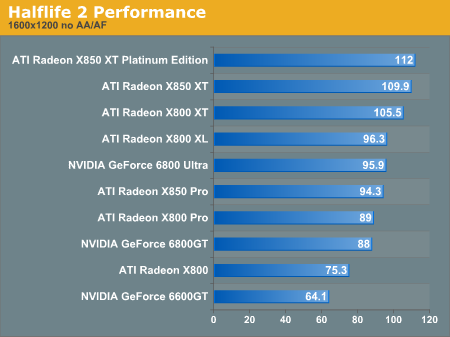
These numbers are in contrast to Doom 3 performance, as should be expected by now. The adoption of the Doom 3 and Source engines in other projects will continue to be of major interest over the next few months. One engine gaining broader acceptance among game developers could help tip the field in either ATI or NVIDIA's direction.
Doom 3
Even the GeForce 6800 GT outperforms ATI’s new highest end $550 offering under Doom 3. The 7% performance lead the 6800 GT holds over the Radeon X850 XT PE is not insignificant. This OpenGL powered, shadow heavy, texture intensive game clearly favors NVIDIA’s architecture, even over all the brute strength ATI can pack into one of their ASICs.
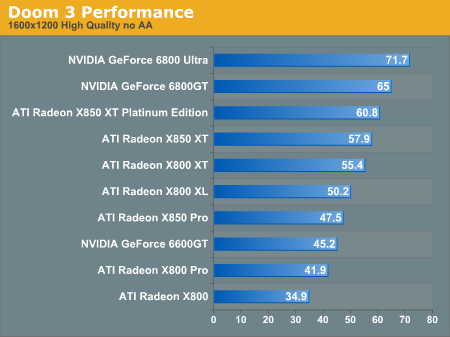
Enabling 4xAA and 8xAF closes the gap between the X850 XT PE and the 6800 GT, as the more expensive card as more memory bandwidth to throw at the problem. It’s hard to keep framerates above a playable 30fps under Doom 3 with these settings, but many of the cards on this list can handle it.

Far Cry
Without AA and AF enabled, the GeForce 6800 Ultra and Radeon X850 XT PE are in a dead heat. The X850 XT and trail these two, with the 6800 GT performing the same as the former top end X800 XT.
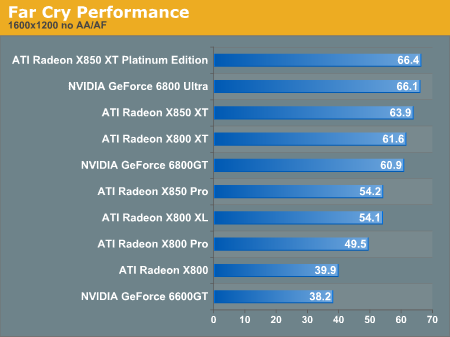
In looking at 4xAA and 8xAF numbers, and the playing field changes a bit. ATI's new top end cards outperform NVIDIA's offering by a good margin. The older X800 XT does hold about a 3% lead over the 6800 Ultra as well, but the X850 line seals the deal. The 6800 GT does a better job of keeping up with its price range, outperforming our X850 Pro numbers and doing as well as the X800 XL.
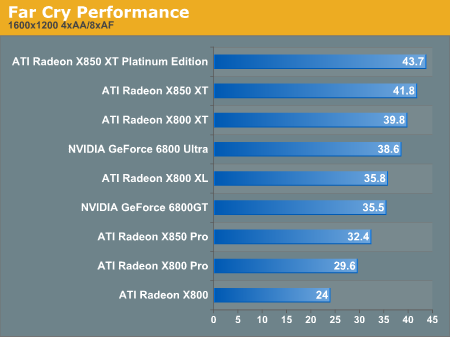
Unreal Tournament 2004
The 6800 Ultra stays a little ahead of the pack, while the rest of the bunch is very even at about 69fps. These numbers aren’t very useful as the GPUs don’t seem to be the limiting factor in game play here. With these high end cards UT2K4 is very CPU bound, even at 1600x1200.
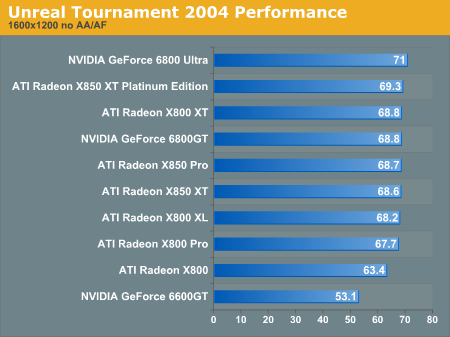
Halo
NVIDIA's GeForce 6800 Ultra manages to keep up with the $500 ATI card, but not the $50 more expensive Radeon X850 XT Platinum Edition. On the midrange side, the 6800 GT puts in better numbers than both the X800 XL and X850 Pro, and comes in just under the previous top of the line X800 XT.
Overall, ATI has had a really strong showing from their new high end and midrange parts, but as much competition as the X800 XL gives the 6800 GT, there really is a gap in the Radeon line up between the $350 price point and the $500 price point, and the current setup on the X850 Pro just isn't going to cut it.
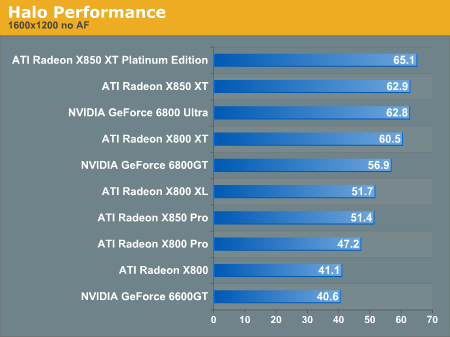
Battlefield Vietnam
ATI leads this benchmark as usual. The GeForce 6800 Ultra comes in between the older X800 XT and the new X800 XL in terms of performance, while the 6800 GT slips humbly between the two twelve pipe Radeon cards.
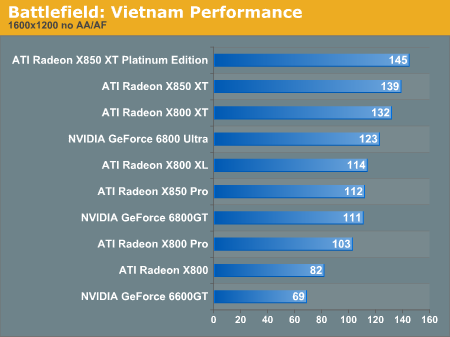
Cranking up the settings pulls the X850 series cards back down to levels the 6800s can match. The Ultra ties the platinum edition, and the GT does the same with the X800 XL. Once again, the X850 Pro puts in a disappointing showing with its high clocks and 12 pixel pipes.
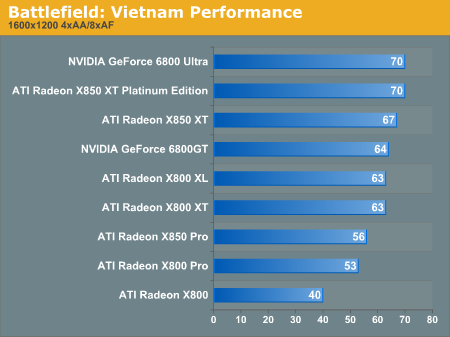
Wolfenstein: ET
Wolfenstein shows the NVIDIA family to have a slight performance lead over ATI, which is to be expected in OpenGL games. This is one of those rare occasions where the X850 Pro actually pulls ahead of the X800 XL as well.
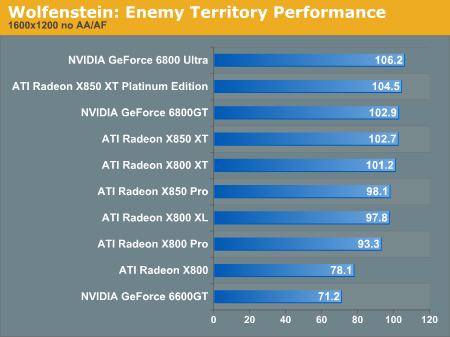
AA and AF give ATI a better foothold on performance under Wolfenstein. The X850 XT PE and X850 XT both pick up a spot in the benchmark, but even the 6800 GT still beats the X800 XT. We're still in NVIDIA territory here.

Final Words
To sum up what we've seen today, ATI is announcing 5 new products, 4 of which are currently viable (the X850 Pro given its current clock speeds/price point just doesn't make sense). There are some very intriguing offers on the table among what's left:
- Radeon X850 XT and X850 XT PE are the extreme gamers cards. They lead in performance and if there's no budget, put this up there with the 6800 Ultra. Of course, ATI says we'll be able to find these on shelves in time to put them in gift boxes for the holiday season, which would tip the scales in ATI's favor, especially if 6800 Ultra cards are still going for extremely high prices and the new X850 XT and XT PE debut at MSRP.
- Radeon X800 XL is an interesting price point. It hits a spot between the current X800 Pro and the 6800 GT. ATI really needs a $400 price point offering, but dropping something between 300 and 400 may help out consumers who don't have the budget for anything more.
- Radeon X800 will take the place of the X700 XT and really negates the need for anything else at a $250 price point. This is a good answer to NVIDIA's 6800 non-ultra product, if they ever make it into the same platform space.
Ideally, we would have liked to see ATI stick with a single slot cooling solution, but if ramping clock speed is important then that's what's got to be done. It is a shame to see ATI lose the single slot advantage they held over NVIDIA, but now both companies are on an equal playing field in that arena.
Of course, as ATI moves to the cooler 110nm solution, they will be able to pull away from the hefty cooling solution. Unfortunately, they're still attracted to the low-k dielectric option TSMC offers on its 130nm process. ATI has seen good success in ramping clock speeds using the 130nm low-k process and they don't want to give that up until they're sure they can surpass that.
In the end we felt that ATI has improved their lineup somewhat, but they have quite possibly done much more to confuse the end user than they did to improve their gaming performance. Looking at the high end X series lineup after today we have the following: X800SE, X800, X800 Pro, X800 XL, X800 XT, X800 XT PE, X850 Pro, X850 XT and X850 XT PE, regardless of how you cut it, that's one confusing lineup. Hopefully we will see most of those cards phased out in the coming weeks/months, but right now we can understand if you're a bit overwhelmed by this seemingly simple launch.
Availability is what will truly determine the success of this product launch - the past year has seen entirely too many attractive GPUs on paper and far too few on store shelves. ATI is claiming that will change here and now and NVIDIA did the same with their 6600GT AGP launch, only time will tell from this point on.







